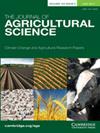白豆对噻那那西混合除草剂的耐受性及噻那那西混合除草剂对多重抗除草剂马草的防治
IF 1.7
4区 农林科学
Q2 AGRICULTURE, MULTIDISCIPLINARY
引用次数: 0
摘要
目前关于白豆对植前施用噻那那烯除草剂的耐受性和植前施用噻那那烯除草剂防治多重抗除草剂(MHR)的效果的研究资料有限。本研究的目的是确定白豆对替那那西混合除草剂的耐受性,并确定是否可以通过在替代大豆作物中添加除草剂伙伴来改善替那那西对MHR马草的控制。在2021年和2022年期间,在加拿大安大略省进行了4项试验,以确定白豆对噻那那烯除草剂混合物的耐受性,并进行了5项试验,以确定噻那那烯混合物对MHR马草的防治效果。除了含有2,4- d酯的混合物外,所有被评估的替那那西混合物都造成了最小的(≤对白豆林分、干生物量、高度、成熟度(以收获时种子水分含量衡量)和产量均无不良影响。草甘膦+替那那尼+ 2,4- d酯和草甘膦+替那那尼+溴硝腈+ 2,4- d酯对白豆造成高达8%的伤害,但对白豆林分、干生物量、高度、成熟度和产量没有不利影响。草甘膦+噻那昔或与溴硝腈、甲霉嗪或2,4- d控制的MHR马草共施用23-75%,减少密度达62%,减少生物量达56%;因此,马草干扰这些替那那西混合物导致大豆产量与未处理(杂草)对照相当。草甘膦+替那那尼+甲基halauxifen-methyl以及草甘膦+替那那尼+溴硝腈与甲曲霉嗪、甲基halauxifen-methyl或2,4- d酯共同施用可控制MHR马草73-94%,降低密度高达79%,减少生物量高达86%。上述噻那那尼混合物减少了MHR马草的干扰,导致大豆产量与无杂草对照相当。结果表明,除含有2,4- d酯的替那那西制剂外,其余制剂均可安全用于白豆。草甘膦+替那那尼+甲基氟化辛,草甘膦+替那那尼+溴硝辛与甲曲霉嗪、甲基氟化辛或2,4- d酯联合施用对MHR马草的控制效果最一致。本文章由计算机程序翻译,如有差异,请以英文原文为准。
Tolerance of White Bean to Tiafenacil Herbicide Mixtures and Control of Multiple Herbicide-Resistant Horseweed With Tiafenacil Herbicide Mixtures
There is limited information on the tolerance of white bean to tiafenacil herbicide mixtures applied preplant (PP) and the efficacy of tiafenacil herbicide mixtures applied PP to control multiple herbicide-resistant (MHR) horseweed. The objective aim of this research was to ascertain the tolerance of white beans to tiafenacil herbicide mixtures and determine if MHR horseweed control with tiafenacil can be improved by adding herbicide partners in a surrogate soybean crop. During 2021 and 2022 four experiments were performed to determine the tolerance of white bean to tiafenacil herbicide mixtures and five experiments were conducted to determine MHR horseweed control with tiafenacil mixtures in ON, Canada. All tiafenacil mixtures evaluated except those that included 2,4-D ester caused minimal (≤ 4%) white bean injury and had no adverse effect on white bean stand, dry biomass, height, maturity (as measured by seed moisture (SM) content at harvest), or yield. Glyphosate + tiafenacil + 2,4-D ester and glyphosate + tiafenacil + bromoxynil + 2,4-D ester caused up to 8% white bean injury but had no adverse effect on white bean stand, dry biomass, height, maturity, or yield. Glyphosate + tiafenacil or co-applied with bromoxynil, metribuzin, or 2,4-D controlled MHR horseweed 23-75%, reduced density up to 62% and reduced biomass up to 56%; consequently, horseweed interference with these tiafenacil mixtures resulted in soybean yield comparable to the non-treated (weedy) control. Glyphosate + tiafenacil + halauxifen-methyl and the co-application of glyphosate + tiafenacil + bromoxynil with metribuzin, halauxifen-methyl, or 2,4-D ester controlled MHR horseweed 73-94%, reduced density up to 79%, and reduced biomass up to 86%. Reduced MHR horseweed interference with the aforementioned tiafenacil mixtures resulted in soybean yield comparable to the weed-free control. In conclusion, all tiafenacil mixtures evaluated except those that contained 2,4-D ester can be safely used in white bean. Glyphosate + tiafenacil + halauxifen-methyl and the co-application of glyphosate + tiafenacil + bromoxynil with metribuzin, halauxifen-methyl, or 2,4-D ester provided the most consistent control of MHR horseweed.
求助全文
通过发布文献求助,成功后即可免费获取论文全文。
去求助
来源期刊

Journal of Agricultural Science
农林科学-农业综合
CiteScore
2.80
自引率
5.00%
发文量
68
审稿时长
1.4 months
期刊介绍:
The Journal of Agricultural Science publishes papers concerned with the advance of agriculture and the use of land resources throughout the world. It publishes original scientific work related to strategic and applied studies in all aspects of agricultural science and exploited species, as well as reviews of scientific topics of current agricultural relevance. Specific topics of interest include (but are not confined to): all aspects of crop and animal physiology, modelling of crop and animal systems, the scientific underpinning of agronomy and husbandry, animal welfare and behaviour, soil science, plant and animal product quality, plant and animal nutrition, engineering solutions, decision support systems, land use, environmental impacts of agriculture and forestry, impacts of climate change, rural biodiversity, experimental design and statistical analysis, and the application of new analytical and study methods (including genetic diversity and molecular biology approaches). The journal also publishes book reviews and letters. Occasional themed issues are published which have recently included centenary reviews, wheat papers and modelling animal systems.
 求助内容:
求助内容: 应助结果提醒方式:
应助结果提醒方式:


